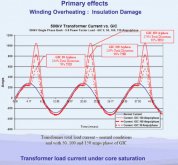Maast
Compulsive Tinkerer
I've been back-of-the-envelope designing supplemental EMP and transients protection for my system using tvs diodes in conjunction with the Midnight lightning arresters (I can build them cheaper than just buying them, but they're inexpensive and the time savings is worth it). I recently saw video on Sol-Arc inverters being "EMP proof" and realized all they really did was include about $15 in tvs diodes to do it.
The Midnights MOVs clamping voltage is something like 470v, which is fine for common mode events like nearby lightning but do nothing for high voltage transients in the grid power lines.
A common mode event is where high voltage is induced in both the positive and negative lines - thus no voltage differential between components. To receive a UL rating among other things the component/system has to be able to withstand a 3000v common mode event without damage.
The design elements include:
MOVs over time wear out from high voltage transients, TVS diodes do not wear out.
MOVs can handle more sustained current in an event. TVS diodes do okay but not as well as MOVs
MOVs reaction time is 8-12ns, TVS diodes are 2-10ps
High alt nuke EMPs rise time is in the ps range, faster than MOVs can react.
Tvs diodes sustained current capacity is dependent on how hot they get
Lightning can strike anywhere in the world. I was living in Iceland and a lightning bolt hit the apartment building next to mine and toasted a modem in my computer and caused damage to the motherboard.
My thought was to encase an array of three to five 300v clamping 1.5kw tvs diodes in a .5"x2"x3" block of thermal transfer epoxy to act as a thermal mass and have one going between each power conductor to earth ground for the PV array, 48V lines, and the in/outgoing AC lines. Each one would cost about $20 in materials - most of that being the epoxy.
In an EMP event the idea is the TVS diodes would clamp just long enough (before saturation or burnout) for the MOVs to begin conducting and short the overvoltage to earth ground. In addition the tvs diodes would clamp any transients thus protecting the equipment and keeping the MOVs from degrading. My primary goal is transient clamping, the EMP protection is a highly desired "just in case".
Thoughts?
The Midnights MOVs clamping voltage is something like 470v, which is fine for common mode events like nearby lightning but do nothing for high voltage transients in the grid power lines.
A common mode event is where high voltage is induced in both the positive and negative lines - thus no voltage differential between components. To receive a UL rating among other things the component/system has to be able to withstand a 3000v common mode event without damage.
The design elements include:
MOVs over time wear out from high voltage transients, TVS diodes do not wear out.
MOVs can handle more sustained current in an event. TVS diodes do okay but not as well as MOVs
MOVs reaction time is 8-12ns, TVS diodes are 2-10ps
High alt nuke EMPs rise time is in the ps range, faster than MOVs can react.
Tvs diodes sustained current capacity is dependent on how hot they get
Lightning can strike anywhere in the world. I was living in Iceland and a lightning bolt hit the apartment building next to mine and toasted a modem in my computer and caused damage to the motherboard.
My thought was to encase an array of three to five 300v clamping 1.5kw tvs diodes in a .5"x2"x3" block of thermal transfer epoxy to act as a thermal mass and have one going between each power conductor to earth ground for the PV array, 48V lines, and the in/outgoing AC lines. Each one would cost about $20 in materials - most of that being the epoxy.
In an EMP event the idea is the TVS diodes would clamp just long enough (before saturation or burnout) for the MOVs to begin conducting and short the overvoltage to earth ground. In addition the tvs diodes would clamp any transients thus protecting the equipment and keeping the MOVs from degrading. My primary goal is transient clamping, the EMP protection is a highly desired "just in case".
Thoughts?



